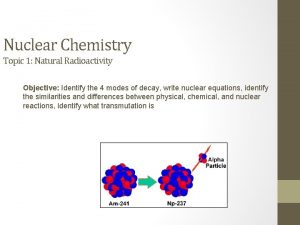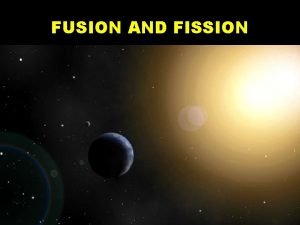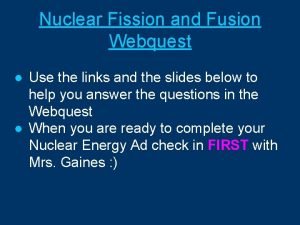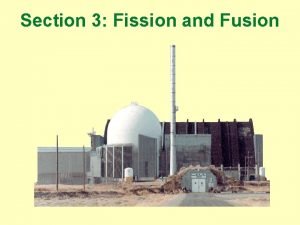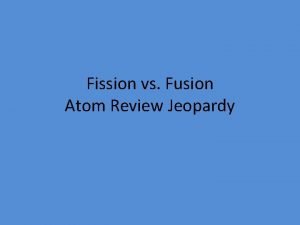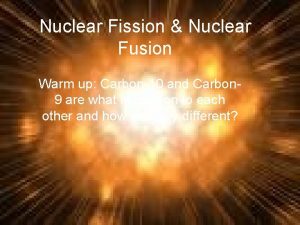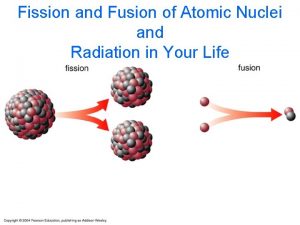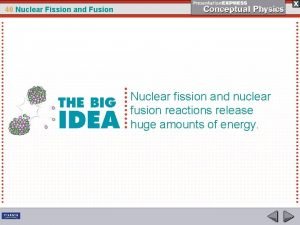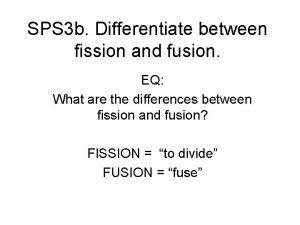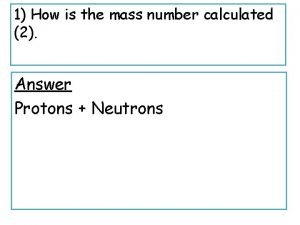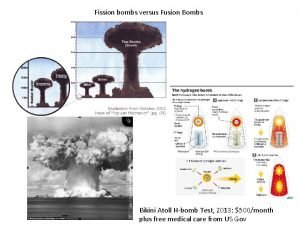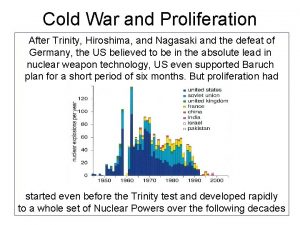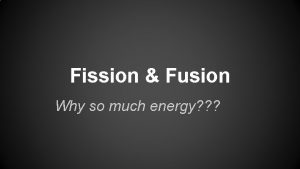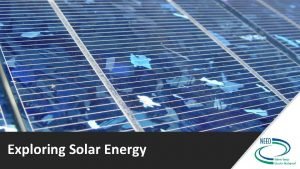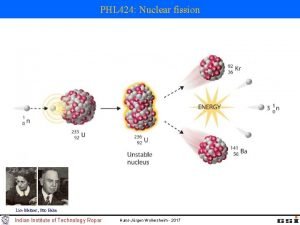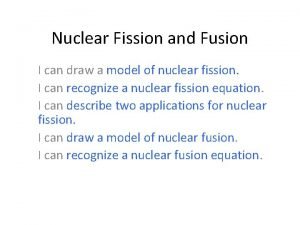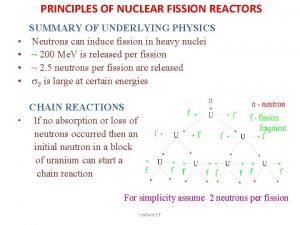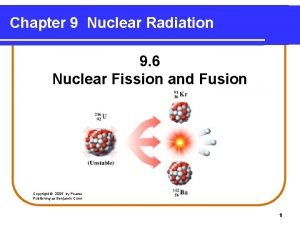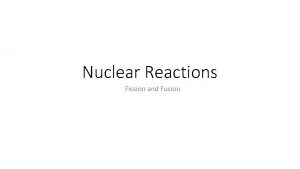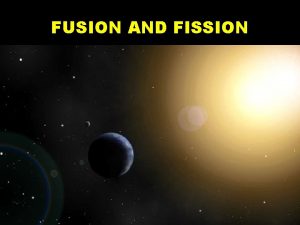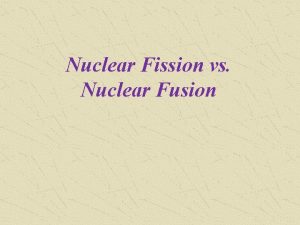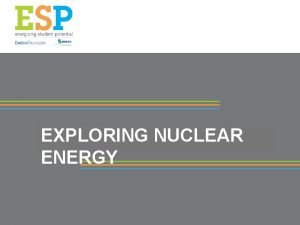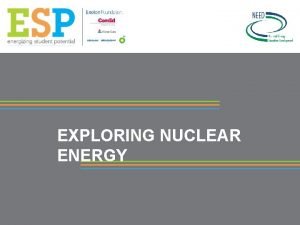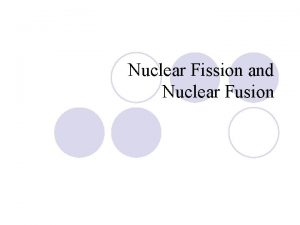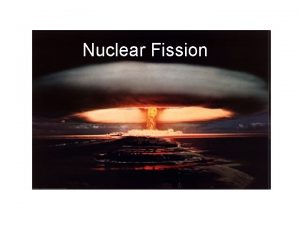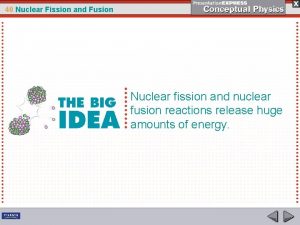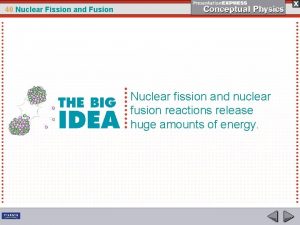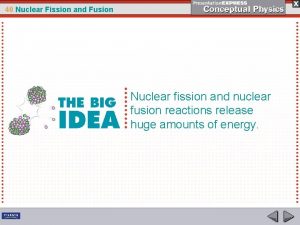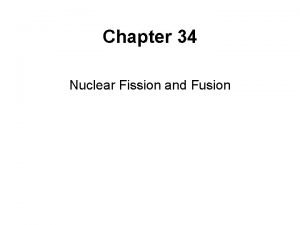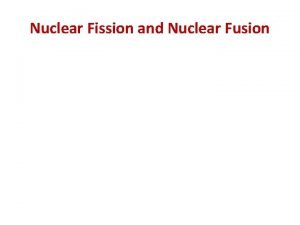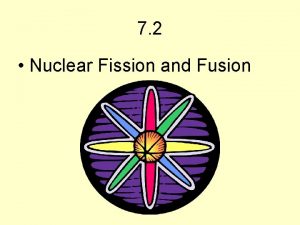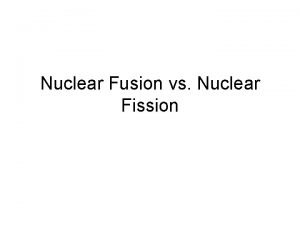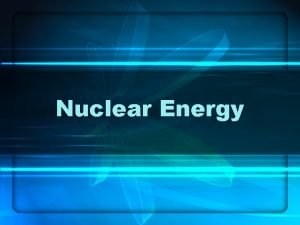Exploring Nuclear Energy Nuclear Fusion and Fission Nuclear


















- Slides: 18

Exploring Nuclear Energy

Nuclear Fusion and Fission • Nuclear Fusion • Small nuclei into large • Immense temperature and pressure • Core of stars • Nuclear Fission • Large nuclei into small • Critical mass to sustain • Two isotopes we use Iron is the “dead end” of both fusion and fission – it is the lowest energy nucleus and cannot be split or fused. Exploring Nuclear Energy 2018 ©The NEED Project

The sun is basically a giant ball of hydrogen gas undergoing fusion and giving off vast amounts of energy in the process. Source: NASA (public domain)

Global Total Primary Energy Supply (TPES) by fuel, 2016 Nuclear provides 5% of total energy and 10% of global electricity generation in 2016. [CATEGORY NAME] 2% 2% [CATEGOR Y NAME] [CATEGORY 10% NAME] 5% Coal* 27% [CATEGORY NAME] 22% Oil 32% Exploring Nuclear Energy 2018 ©The NEED Project Data: International Energy Agency *In this graph peat and oil shale are aggregated with coal

Top 5 Nuclear Electricity Generating Countries, 2015 Source: U. S. Energy Information Administration, International Energy Statistics Exploring Nuclear Energy 2018 ©The NEED Project

Primary Energy Consumption by Source and Sector Source: Energy Information Administration

U. S. Electricity Production, 2016 Biomass Wind Hydropower Petroleum 0. 6% Nuclear power plants have supplied about 20% of annual U. S. electricity generation since 1990. 1. 5% Solar 0. 9% Geothermal 0. 4% 5. 6% 6. 4% Natural Gas 34. 0% Nuclear 19. 9% Data: EIA Coal 30. 6% *Total does not equal 100% due to independent rounding. Data: Energy Information Administration Exploring Nuclear Energy 2018 ©The NEED Project

Exploring Nuclear Energy 2018 ©The NEED Project

Nuclear Energy Production


Anatomy of a Nuclear Power Plant Source: NRC Exploring Nuclear Energy 2018 ©The NEED Project

Anatomy of a Nuclear Power Plant Source: NRC Exploring Nuclear Energy 2018 ©The NEED Project

Advantages of Nuclear Power • Clean • Plentiful Supply • High energy content in uranium • Small fuel pellet • Can provide base load power • Energy savings in transportation • Operating cost is low after construction Exploring Nuclear Energy 2018 ©The NEED Project

Drawbacks to Using Nuclear Power • • • Initial construction costs Radioactive waste byproduct Storage Natural disasters Public perception Exploring Nuclear Energy 2018 ©The NEED Project

New Nuclear Technologies • Modular, small-scale reactors • Breeder reactors • http: //www. energy. gov/science-innovation/energy-sources/nuclear Image courtesy of Department of Energy Exploring Nuclear Energy 2018 ©The NEED Project

Food for thought… Of the 15 methods (wedges) proposed by a Princeton University study to stabilize Carbon Dioxide emissions, 13 of them relate to energy use. Implementation of any 7 would accomplish the goal of stabilizing emissions. 1. Efficient vehicles 2. Reduced use of vehicles 3. Efficient buildings 4. Efficient coal power plants 5. Gas instead of coal power plants 6. Capture CO 2 at base load power plant 7. Nuclear power for coal power 8. Wind power for coal power 9. Photovoltaic power for coal power 10. Capture CO 2 at H 2 plant 11. Capture CO 2 at coal-to-synfuels plant 12. Wind H 2 in fuel-cell car for gasoline in hybrid car 13. Biomass fuel for fossil fuel Exploring Nuclear Energy 2018 ©The NEED Project

For More Information • The NEED Project www. need. org info@need. org 1 -800 -875 -5029 • Energy Information Administration U. S. Department of Energy www. eia. gov Exploring Nuclear Energy 2018 ©The NEED Project

NEED IS SOCIAL! Let’s be Facebook (@needproject) official! Events, energy news, and more! Follow us on Twitter (@NEED_Project)! We share the latest energy news from around the country. Follow us on Instagram (@theneedproject) and check out photos from workshops and when we go live for hands-on experiments. Follow us on Pinterest and pin ideas to use in your classroom. www. pinterest. com/needproject Subscribe to our You. Tube channel. Hands-on energy lesson tutorials, interviews with energy career professionals, & more! www. youtube. com/user/needproject NEED is social! ©The NEED Project
 Natural vs artificial radioactivity
Natural vs artificial radioactivity Nuclear fission and fusion similarities
Nuclear fission and fusion similarities Sun fission
Sun fission Fission vs fusion
Fission vs fusion What is fission and fusion
What is fission and fusion Nuclear fission vs fusion venn diagram
Nuclear fission vs fusion venn diagram Are nuclear power plants fission or fusion
Are nuclear power plants fission or fusion Fusion fission
Fusion fission Fission vs fusion
Fission vs fusion Fusion or fission
Fusion or fission How is mass number calculated
How is mass number calculated Fission vs fusion
Fission vs fusion Fission vs fusion
Fission vs fusion Fusion or fission
Fusion or fission Radiant energy
Radiant energy Nuclear fission lise meitner
Nuclear fission lise meitner Nuclear fission applications
Nuclear fission applications Nuclear fission summary
Nuclear fission summary Nuclear fission radiation
Nuclear fission radiation

